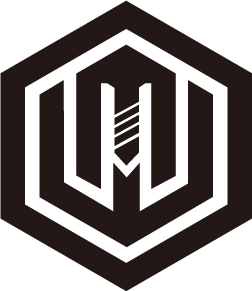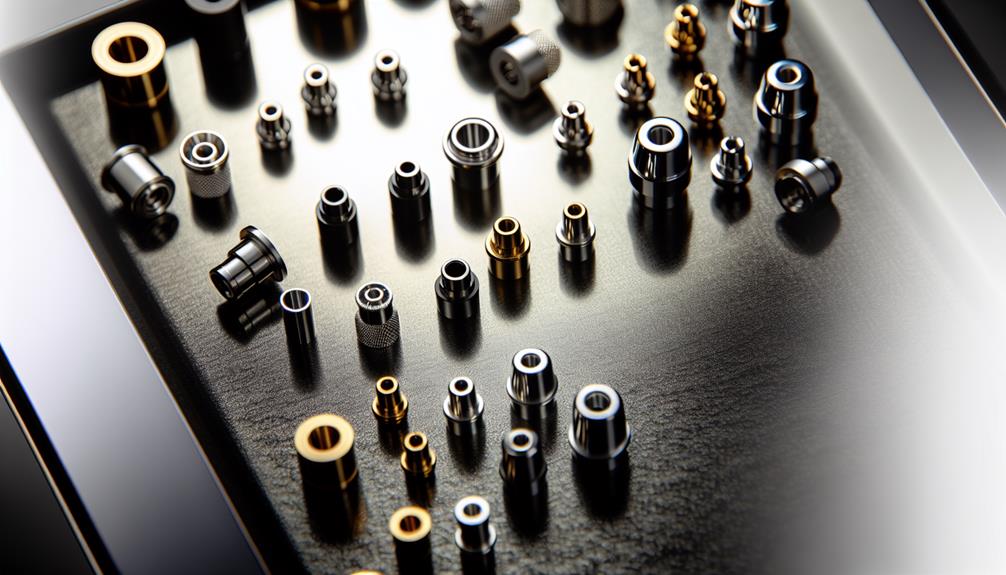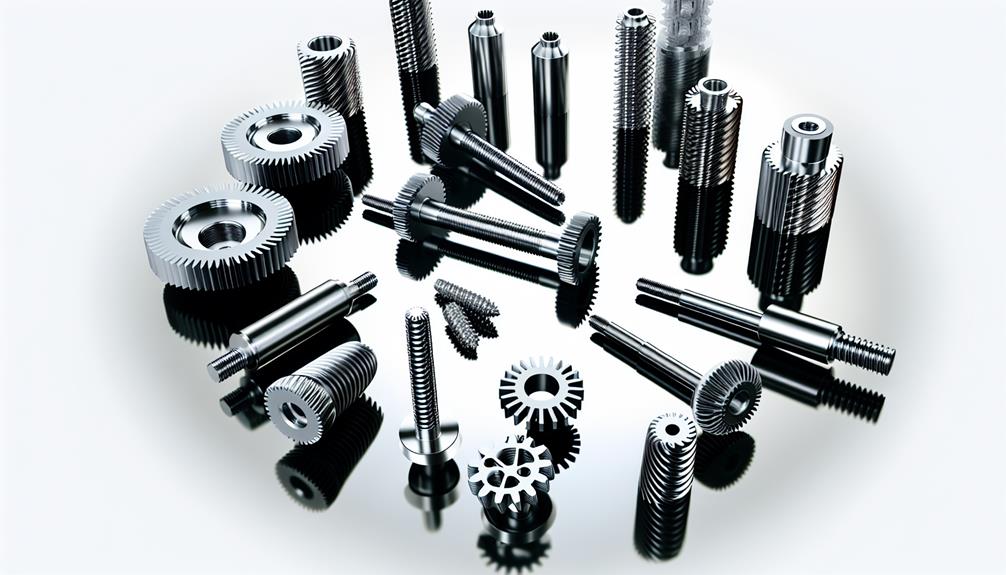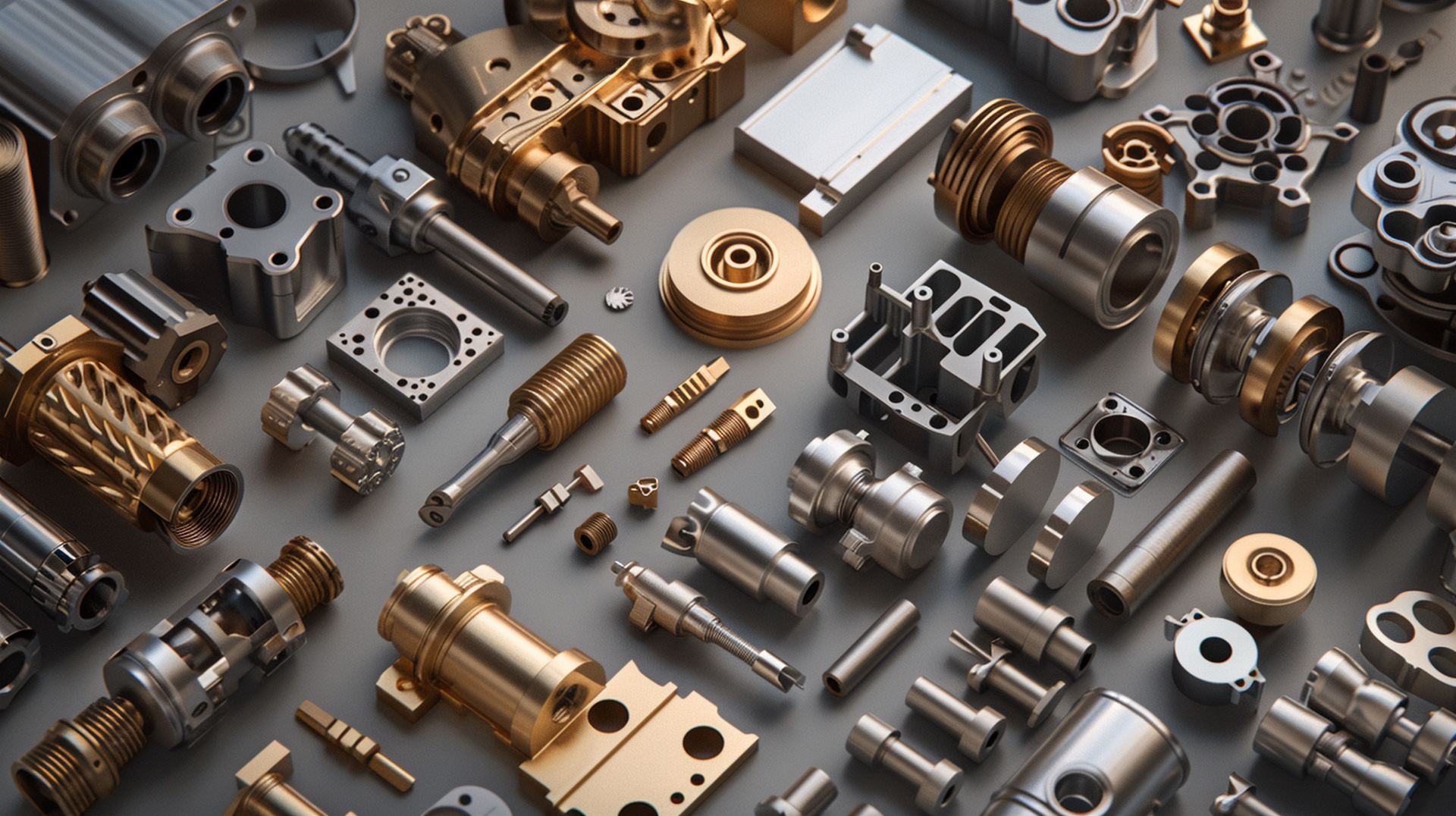Metal CNC Machined Parts Explained: Types, Materials, and Manufacturing Processes
The advent of CNC technology has revolutionized the production of metal parts, ensuring high precision and efficiency in manufacturing processes. As industries such as aerospace and automotive continue to demand exacting standards, understanding the various types of CNC machined metal parts, alongside the materials suitable for these applications, becomes crucial. Exploring these elements reveals the intricate balance between material properties, design complexity, and cost-effectiveness. However, the question remains: how do these factors influence the final choice in the manufacturing process, and what innovations in CNC technology are on the horizon that could further enhance production capabilities?
Key Takeaways
- CNC machining utilizes advanced technology to produce precision metal parts like gears, bushings, and manifolds.
- Common metals used include aluminum, stainless steel, brass, and titanium, each offering unique machining properties.
- Key manufacturing processes involve routers, grinders, mills, and lathes, tailored to specific metal characteristics.
- Applications span industries such as aerospace, automotive, and medical devices, benefiting from high precision and custom designs.
- Design considerations for CNC parts include internal corner fillets, wall thickness, and crucial surface finish requirements.
1. What Are CNC Machined Metal Parts?

CNC machined metal parts are precision components fabricated using Computer Numeric Control technology to operate various tools such as routers, grinders, mills, and lathes. This process capitalizes on CNC technology to manipulate metal properties with unmatched precision, ensuring components meet stringent specifications essential for high-stakes industrial applications.
Material selection plays a pivotal role in precision manufacturing of CNC machined parts. The choice of metal affects not only the machining process but also the performance and durability of the finished components. Metals are selected based on their strength, hardness, resistance to corrosion, and thermal properties, aligning these material properties with the demands of their intended application.
The use of CNC technology in manufacturing allows for high-level control over production processes, resulting in parts with highly repeatable and consistent qualities. This capability is crucial in industries where precision is paramount, such as aerospace, automotive, and healthcare.
2. Types of Metal CNC Machined Parts

CNC machining is integral to various industries, allowing for the production of precision parts. Here are some common types of metal CNC machined parts:
Brackets
Providing support and stabilization, CNC machined brackets are used in construction, automotive, and machinery applications.
Gears
Used in machinery to transmit motion and torque, CNC machined gears are crafted for precision and reliability.
Bushings
These cylindrical components serve as a low-friction interface between two parts, often used in rotating applications.
Manifolds
Manifolds are crucial in fluid and gas distribution systems, designed to efficiently direct flow through various channels.
Fittings
CNC machined fittings connect pipes or hoses, ensuring secure and leak-proof connections in plumbing and hydraulic systems.
Housings
Protecting internal components, housings are designed for strength and durability in applications ranging from electronics to automotive parts.
Suspension Arms
These components are vital in vehicle suspension systems, providing stability and control for enhanced ride quality.
Ball Joints
Allowing for a range of motion, ball joints are essential in vehicle steering and suspension systems for smooth operation.
Rollers
Used in various applications, including conveyor systems, rollers facilitate movement and reduce friction.
3. The Applications of Metal CNC Machined Parts

Metal CNC machined parts are integral to industries such as aerospace, automotive, electronics, medical devices, and the manufacturing of both pneumatic and hydraulic systems.
Here's a table outlining the applications of metal CNC machined parts:
| Application Area | Description |
|---|---|
| Aerospace | Components for aircraft and spacecraft, including structural and engine parts. |
| Automotive | Precision parts for engines, transmissions, and suspension systems. |
| Electronics | Housing and components for electronic devices, ensuring functionality and safety. |
| Medical Devices | Critical components for surgical instruments and medical equipment, emphasizing precision and hygiene. |
| Pneumatic Parts | Parts for systems that use compressed air to perform work, such as valves and cylinders. |
| Hydraulic Parts | Components for systems that use fluid pressure to generate movement, including pumps and fittings. |
4. Advantages of Metal CNC Machining Parts

Precision and Consistency
CNC machining ensures high accuracy and repeatability, resulting in consistently precise parts across batches.
Versatility in Design and Material
It can machine a wide range of materials and complex designs, allowing for custom solutions tailored to specific needs.
Quick Production and Prototyping
This process significantly reduces lead times, enabling faster prototyping and production of parts.
Durable and Strong Parts
Metal CNC machined parts offer superior strength and durability, making them suitable for demanding applications.
Design Freedom
Designers can create intricate shapes and features, providing flexibility in engineering solutions.
5. Common Metals Used in CNC Machining

Building on the benefits of CNC machining, it is important to explore the range of metals typically used in this process, including aluminum, stainless steels, copper, brass, titanium, and magnesium. Material selection is crucial as each metal brings unique properties that affect the machining techniques, surface finishes, tolerances, and cost considerations essential for project success.
Aluminum
Known for its lightweight properties, excellent machinability, and corrosion resistance, aluminum is widely used for parts in industries like automotive and aerospace.
Stainless Steels
Valued for its strength and resistance to corrosion, stainless steel is used in a range of applications from medical devices to structural components.
Copper
With excellent electrical conductivity, copper is ideal for electrical components and parts that require heat dissipation.
Brass
Brass offers good machinability and corrosion resistance, making it suitable for fittings, valves, and decorative parts.
Titanium
This metal is known for its high strength-to-weight ratio and resistance to extreme environments, used primarily in aerospace and medical applications.
Magnesium
Magnesium is an exceptionally lightweight metal, offering good machinability and is often used in applications requiring minimal weight without compromising strength.
These metals are commonly selected in CNC machining based on their properties, each fitting specific application needs across various industries.
6. How to Manufacture Metal Parts?

Various manufacturing processes are available for producing metal parts, each suited to different design requirements and material characteristics.
- CNC Machining
CNC machining involves removing material from a solid block to create precise parts, offering high accuracy and flexibility in design. - Extrusion
In this process, metal is forced through a die to produce long parts with a fixed cross-sectional profile, ideal for lightweight structural components. - Stamping
Stamping involves cutting and forming metal sheets into specific shapes using a press, commonly used for mass production of parts with consistent dimensions. - Forging
Forging shapes metal by applying compressive forces, producing strong and durable parts often used in demanding applications like automotive and aerospace. - Casting
This process involves pouring molten metal into a mold to form complex parts, suitable for large-scale production and parts with intricate details. - Metal Injection Molding
Metal powder is injected into a mold and then solidified, used for producing small, complex parts in high volumes. - Metal 3D Printing
Additive manufacturing builds metal parts layer by layer, ideal for creating complex geometries and prototypes with minimal material waste. - Surface Finish Options for Metal Parts
After manufacturing, parts can undergo various finishing processes such as anodizing, plating, or polishing to enhance their appearance, durability, and corrosion resistance.
These methods offer a range of solutions for manufacturing metal parts, depending on the complexity, material, and application.
7. Design for Machined Parts

Designing for machined parts involves carefully considering various factors such as geometry, tolerances, and material properties to ensure optimal performance, durability, and cost-efficiency. By adhering to these design elements, manufacturers can avoid common machining issues and create high-quality parts suited for various applications.
| Design Element | Description |
|---|---|
| Inside Corner Radii | Rounded corners to reduce stress concentration and improve machinability. |
| Pockets | Depressions in the part, commonly used in enclosures or housing designs. |
| Internal Corner Fillets | Smooth transitions between surfaces to increase part strength and reduce wear. |
| Floor Fillets | Rounded edges at the bottom of pockets or cavities to enhance tool life. |
| Cavities | Hollowed-out sections for weight reduction or housing other components. |
| Pre-Drill Tapping Depth | Depth of holes drilled for threading, ensuring strong, secure fastener fit. |
| Tapped Holes | Threaded holes for bolts or screws, allowing for assembly or attachment. |
| Undercuts | Recessed areas that are difficult to machine but necessary for complex designs. |
| Wall Thickness | Consistent thickness for strength and machinability without warping or failure. |
| Text and Lettering | Custom engravings or markings, useful for branding or identification. |
| Surface Finish | The texture and smoothness of the part’s surface after machining. |
| Machined Part Tolerances | Tight control over dimensions for accurate, high-quality parts. |
Good design practices for machined parts enhance machinability, reduce production costs, and improve product longevity. By focusing on elements such as radii, pockets, and surface finishes, manufacturers can achieve precision and efficiency in metal CNC machining projects.
8. Considerasion for Choosing A Metal for CNC Machining

When selecting a metal for CNC machining, it is crucial to consider factors such as machining speed and efficiency, strength and environmental compatibility, and the available finishing and post-processing options. Understanding these aspects ensures not only the quality and durability of the machined parts but also their cost-effectiveness and environmental footprint.
Key considerations include:
- Material Selection: Choosing the right metal affects everything from machining speed to cost. Harder metals may offer durability but can reduce machining speed and increase tool wear, impacting overall costs.
- Machining Considerations: Evaluate the complexity of the design to determine the suitability of a metal. Metals that allow for high-speed machining can reduce cycle times and costs.
- Surface Finishes: Different metals respond differently to surface finishing techniques, which can affect the appearance, performance, and longevity of the part. Optimal material choice should align with the desired aesthetic and functional requirements.
Incorporating a thorough cost analysis and understanding the environmental impact of different metals can refine your CNC machining strategy. Metals that are both cost-effective and have a lower environmental impact are preferable for sustainable manufacturing practices, aligning with a strategic approach to machining that prioritizes efficiency and environmental responsibility.
9. How to Outsource Metal CNC Machined Parts?

Outsourcing metal CNC machined parts can improve efficiency and reduce costs if done correctly. Here are three key steps:
Step1 Define Your Requirements
Start by clearly specifying your needs—metal type, tolerance, surface finishes, and quantities. Providing detailed drawings or CAD files ensures clarity and avoids potential misunderstandings.
Step2 Select a Reliable Partner
Choose a supplier with proven CNC expertise and a solid track record. Ensure they can handle your materials and meet quality standards, and review their past projects for reliability.
Step3 Develop a Collaborative Relationship
Establish open communication to ensure smooth operations. A strong relationship helps in addressing issues quickly and improves long-term project success.
By following these steps, you can ensure a smooth outsourcing process and high-quality results.
Frequently Asked Questions
Can CNC Machining Produce Parts for Aerospace Applications?
Yes, CNC machining is adept at producing aerospace components, ensuring high precision and adherence to industry standards. It excels in material compatibility and quality assurance, vital for the demanding aerospace sector.
What Is the Typical Tolerance Achievable With CNC Machining?
The typical tolerance achievable with CNC machining depends on material selection, tool wear, design considerations, and quality control measures. Optimal surface finish also influences precision, generally ranging between ±0.005 inches to ±0.0005 inches.
How Does CNC Machining Impact the Environment?
How can we overlook the environmental footprint of CNC machining? This process significantly affects sustainability through high energy consumption, waste production, and carbon emissions, urging the adoption of improved sustainability measures and waste reduction strategies.
Are There Any Recycling Practices for CNC Machined Metal Scraps?
Yes, metal scrap recycling is integral to CNC machining, promoting sustainability practices. It supports the circular economy by reducing waste and minimizing environmental impact through the reuse of valuable material resources.
How Do CNC Machines Handle Extremely Hard Metals?
CNC machines handle extremely hard metals using advanced cutting techniques, specialized heat treatment, and optimal lubrication methods to minimize tool wear and ensure superior surface finish, maintaining control over the machining process.
Mikehardware-your trusted Metal CNC Machined Parts manufacturer
In conclusion, the pivotal role of CNC machined metal parts in modern industrial applications cannot be overstated. From aerospace to automotive, these components ensure high precision and efficiency.
How will industries continue to evolve with advancements in CNC technology? As the demand for precision and customization grows, the importance of understanding these machining processes and materials becomes paramount.
The future of manufacturing will undoubtedly rely heavily on the innovation and optimization of CNC machining techniques.
At Dongguan Mike Hardware Co., Ltd., precision engineering meets innovation, delivering impeccable CNC product manufacturing solutions. Explore our array of customized fasteners, screws, and coatings, ensuring your projects excel in performance, precision, and quality.
Elevate your engineering prowess with our tailored solutions—Contact us for a free quote of your ideal metal cnc machined parts.




